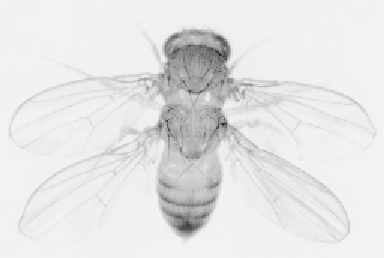Biology Reference
In-Depth Information
Since the first homeobox sequence was isolated from the
Antennapedia
+
gene in late 1983, it has been used as a probe to identify and isolate previously
unknown homeotic genes from
Drosophila
. Furthermore, because the homeo-
box is evolutionarily conserved, this
Drosophila
sequence was used as a probe to
identify homeotic genes from other species, including humans (
Gehring 1985
).
One of the homeobox sequences of
Xenopus
is so similar to the
Antennapedia
homeobox in
Drosophila
that only one amino acid of 60 is different. The rea-
son for this extraordinary conservation during evolution is not fully understood
(
Gehring 1987
). The sequences of the different
Hox
components in the verte-
brate and insect gene clusters are comparable, as well as the order of those ele-
ments on the chromosome (
Nam and Nei 2005
). This remarkable conservation
suggests that there may have been an ancestral sequence common to flies and
humans (
Lawrence 1992
).
Homeotic mutants may have segments that are transformed dramatically. For
example, antennal segments may be transformed into leg-like structures, and
metathoracic segments with halteres may be transformed into mesothoracic seg-
ments with a set of wings (
Figure 4.8
). The four-winged
D. melanogaster
shown
in
Figure 4.8
is the result of combining three separate mutated genes in one fly!
Normally, of course, a pair of wings is found on the second thoracic segment and
a pair of balancing organs, called halteres, is on the third. However, this fly has
two essentially normal second thoraces (and no third thoracic segment) because
the combined effect of the three mutations is to transform the third thoracic
segment into the second without affecting any other parts of the fly.
Figure 4.8
A four-winged
Drosophila melanogaster
fly showing a complete transformation of the
third thoracic segment into a second thoracic segment. The fly carries one chromosome with a
deletion of the homeotic bithorax complex, while the other chromosome carries mutations of the
bithorax
(
Abx
,
bx3
) and
postbithorax
(
pbx
) loci.
(Photograph provided by Edward Lewis, California Institute of
Technology.)

